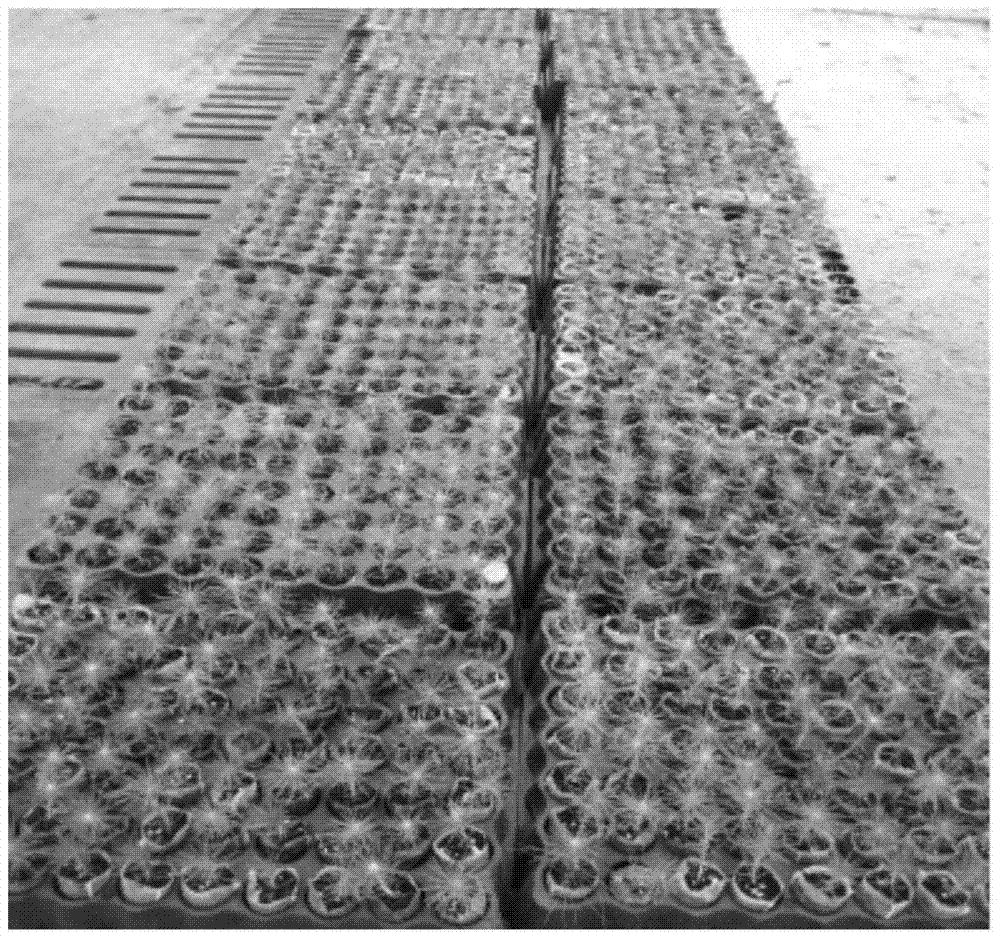Method for Seedling Cultivation of Pine Masson Tissue Cultured Seedlings by Cutting Short Branches and Short Spikes
A technique for raising seedlings by cuttings and Pinus massoniana, applied in the field of plant reproduction, can solve the problems of unstable rooting effect, low reproduction coefficient of cuttings, unsatisfactory rooting rate, etc., achieves easy rooting by cuttings, overcomes long tissue culture subgeneration cycle, improves Yield and effect of cuttings
- Summary
- Abstract
- Description
- Claims
- Application Information
AI Technical Summary
Problems solved by technology
Method used
Image
Examples
Embodiment 1
[0029] A method for cutting seedlings of masson pine tissue culture seedlings with short ears and twigs. A 70-hole seedling tray with a hole size of 6 cm×8 cm and a serrated hole on the side of the hole is selected as a cutting seedling container. Mix the fermented pine bark, coconut bran, yellow heart soil, and pumice at a volume ratio of 2:2:4:2 to obtain a seedling substrate. Put the seedling substrate into a non-woven seedling bag with a size of 8 cm×9 cm. Place it in the seedling tray, and then pour the filled seedling substrate with water. Use a mixture of 0.1% carbendazim + 0.5% potassium permanganate to sterilize the seedling substrate for use. When cutting, the seedlings are grown in the seedling bag The water content of the matrix is controlled at 65%.
[0030] Select the soft and vigorous young masson pine twigs with a length of 3 cm and a diameter of 4 mm or more that are newly ligninized, and the top needles are clustered as cuttings; the cuttings collected are qui...
Embodiment 2
[0034] A method for cutting seedlings of masson pine tissue culture seedlings with short ears and twigs. A 70-hole seedling tray with a hole size of 6 cm×8 cm and a serrated hole on the side of the hole is selected as a cutting seedling container. Mix the fermented pine bark, coconut bran, yellow heart soil, and pumice at a volume ratio of 2:2:4:2 to obtain a seedling substrate. Put the seedling substrate into a non-woven seedling bag with a size of 8 cm×9 cm. Place it in the seedling tray, and then pour the filled seedling substrate with water. Use a mixture of 0.3% carbendazim + 0.5% potassium permanganate to sterilize the seedling substrate for later use. When cutting, seedlings are grown in the seedling bag The water content of the substrate is controlled at 75%.
[0035] Select the newly harvested 4 cm long, 4 mm diameter or more, initially lignified, soft and vigorous young masson pine shoots with clustered needles at the top as cuttings; quickly immerse the collected cutti...
Embodiment 3
[0039] A method for cutting seedlings of masson pine tissue culture seedlings with short ears and twigs. A 70-hole seedling tray with a hole size of 6 cm×8 cm and a serrated hole on the side of the hole is selected as a cutting seedling container. Mix the fermented pine bark, coconut bran, yellow heart soil, and pumice at a volume ratio of 2:2:4:2 to obtain a seedling substrate. Put the seedling substrate into a non-woven seedling bag with a size of 8 cm×9 cm. Place it in the seedling tray, then pour the filled seedling substrate with water, and use a mixture of 0.2% carbendazim + 0.5% potassium permanganate to disinfect the seedling substrate for use. When cutting, the seedlings are grown in the seedling bag The water content of the substrate is controlled at 70%.
[0040] Select the soft and vigorous young masson pine twigs with a length of 3 cm and a diameter of 4 mm or more that are newly ligninized, and the top needles are clustered as cuttings; the cuttings collected are qu...
PUM
 Login to View More
Login to View More Abstract
Description
Claims
Application Information
 Login to View More
Login to View More - R&D
- Intellectual Property
- Life Sciences
- Materials
- Tech Scout
- Unparalleled Data Quality
- Higher Quality Content
- 60% Fewer Hallucinations
Browse by: Latest US Patents, China's latest patents, Technical Efficacy Thesaurus, Application Domain, Technology Topic, Popular Technical Reports.
© 2025 PatSnap. All rights reserved.Legal|Privacy policy|Modern Slavery Act Transparency Statement|Sitemap|About US| Contact US: help@patsnap.com



